Thus, if you estimate that a certain 25 mm dia shaft can work satisfactorily with a tolerance of +/- 0.1 mm (ie. any diameter between 24.9 and 25.1 mm is workable) then a tolerance of +/- 0.01 mm should not be specified because the increased accuracy requires
- a more skilled operative,
- a more sophisticated machining process,
- a more accurate measuring device,
- more time spent in checking size during manufacture, etc
- - all of which lead to unnecessary expense.
Use the least skilled labour and the least sophisticated processes possible - though this outlook does not apply when mass production is contemplated.
If the size of a certain shaft to satisfy fatigue strength, lubrication and other necessities is calculated to be 23.4 mm, then the use of 25 mm dia bar stock should be considered - provided the surface finish of off-the-shelf bright stock is adequate, and the larger size does not compromise other components. The resulting 'waste' of material is usually more than offset by savings in manufacturing time.
If a design calls for a component which is very similar to the existing part of another assemblage then you should examine the possibility of changing the design to adapt that part, perhaps modified slightly. This Lego / Meccano outlook is referred to as Value Analysis - a tool for reducing machining and the variety of parts which must be held in stock for later assembly and/or spares. Stock represents an investment which is just sitting there, requiring interest to be paid on the investment, and not earning profits.
If you are not aware of what these could be, find out. For example, the steps in casting a flat belt pulley are essentially as follows. A wooden or plastic pattern is surrounded by a flask as shown in cross-section, Fig A below. This is filled with moulding sand which is consolidated by ramming before the lid is fitted, Fig B.
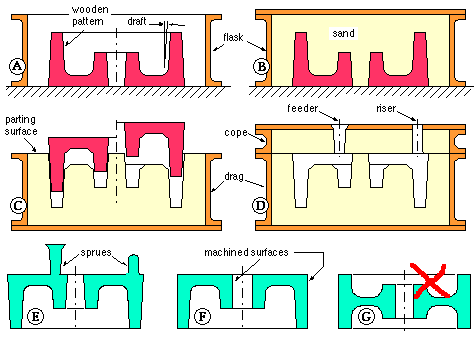 |
A designer who was not conversant with this process might have specified the design of Fig G which will be more expensive as it has the following disadvantages :
- there is no draft which allows pattern withdrawl from the sand without damage, Fig C
- the thin web solidifies first due to heat transfer, and will be torn by massive sections which solidify and contract later, unless special conductors are inserted; this tendency is exacerbated by large blending radii here
- the non-flat parting surface requires awkward consolidation of sand around the pattern in the cope, rather than easily on a flat surface, Fig D
- . . . . and so on - there are many texts devoted to the details of casting design.
Students were asked to design a sheet-metal domestic letterbox to be made in reasonable quantities by a jobbing shop, using conventional manual techniques - mass production processes, such as heavy presswork, were not available. A typical design, involving slanting sides and a curved top for aesthetics and a hinged rear panel for access, is illustrated.
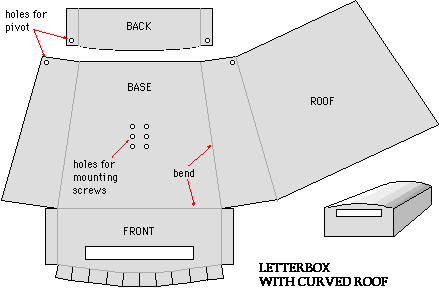
|
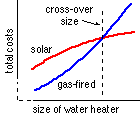 Suppose for example a buyer requires a water heater for a certain application, and the choice lies between gas-fired and solar heaters. Knowing the initial prices of various sizes of each, the price of gas, the expected solar insolation, and making some allowance for foreseeable maintenance etc, the buyer can build up a picture as shown here. The solar heater will come into its own in the larger sizes as the 'fuel' costs are negligible. From this picture buyers can determine that, if their installation is below the cross-over size then they should select a gas-fired heater, otherwise they should select a solar. Buyers will try to assess what they are buying before parting with hard earned cash, so designers must weigh up carefully what they are trying to sell and how buyers will view it.
Suppose for example a buyer requires a water heater for a certain application, and the choice lies between gas-fired and solar heaters. Knowing the initial prices of various sizes of each, the price of gas, the expected solar insolation, and making some allowance for foreseeable maintenance etc, the buyer can build up a picture as shown here. The solar heater will come into its own in the larger sizes as the 'fuel' costs are negligible. From this picture buyers can determine that, if their installation is below the cross-over size then they should select a gas-fired heater, otherwise they should select a solar. Buyers will try to assess what they are buying before parting with hard earned cash, so designers must weigh up carefully what they are trying to sell and how buyers will view it.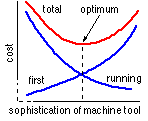 As the models become more sophisticated the initial price rises but the time spent in machining a given batch of components decreases, leading to a reduction in running costs. The total costs for machining a particular part exhibit a clear minimum, so the model corresponding to this degree of sophistication should be bought to machine that part - though other non-economic arguments would have to be considered of course.
As the models become more sophisticated the initial price rises but the time spent in machining a given batch of components decreases, leading to a reduction in running costs. The total costs for machining a particular part exhibit a clear minimum, so the model corresponding to this degree of sophistication should be bought to machine that part - though other non-economic arguments would have to be considered of course.
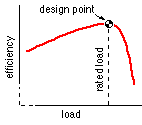
 A final instance of economic reasoning concerns the supply of power to the electricity grid by a number of steam-powered turbo-alternators, some of which are large, some old, some out of service for (hopefully routine) maintenance, and so on. A major problem is in deciding which turbo-alternators should be generating at any one time for minimum overall running costs,
A final instance of economic reasoning concerns the supply of power to the electricity grid by a number of steam-powered turbo-alternators, some of which are large, some old, some out of service for (hopefully routine) maintenance, and so on. A major problem is in deciding which turbo-alternators should be generating at any one time for minimum overall running costs, 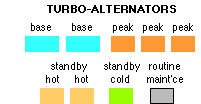 given the expected daily variation of demand in the grid as shown. The newest, largest and most efficient turbo-generators are driven constantly at their rated load, supplying the grid's base load. The load on the smaller less efficient machines varies, as dictated by demand peaks. Other machines are on hot standby, ready for unexpected demand or breakdown of other generators.
given the expected daily variation of demand in the grid as shown. The newest, largest and most efficient turbo-generators are driven constantly at their rated load, supplying the grid's base load. The load on the smaller less efficient machines varies, as dictated by demand peaks. Other machines are on hot standby, ready for unexpected demand or breakdown of other generators.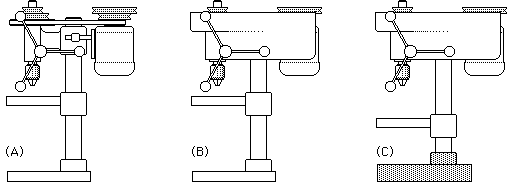
 On resolution of the labour difficulties, management - which has little empathy with things engineering - decrees that all processing machines will operate flat out until production has caught up with the backlog. The result ? Breakdown of machines. No.2 crusher is the first to wilt under the strain of being asked to do more than it was designed to do. Stockpiles may allow the rest of the plant to continue to operate for a limited period while this machine is repaired, as suggested by the sketch, but further breakdowns can obviously be expected.
On resolution of the labour difficulties, management - which has little empathy with things engineering - decrees that all processing machines will operate flat out until production has caught up with the backlog. The result ? Breakdown of machines. No.2 crusher is the first to wilt under the strain of being asked to do more than it was designed to do. Stockpiles may allow the rest of the plant to continue to operate for a limited period while this machine is repaired, as suggested by the sketch, but further breakdowns can obviously be expected. 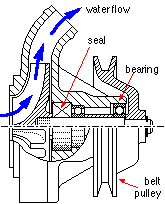 opposed to individual spare components may be an attractive proposition.
opposed to individual spare components may be an attractive proposition.